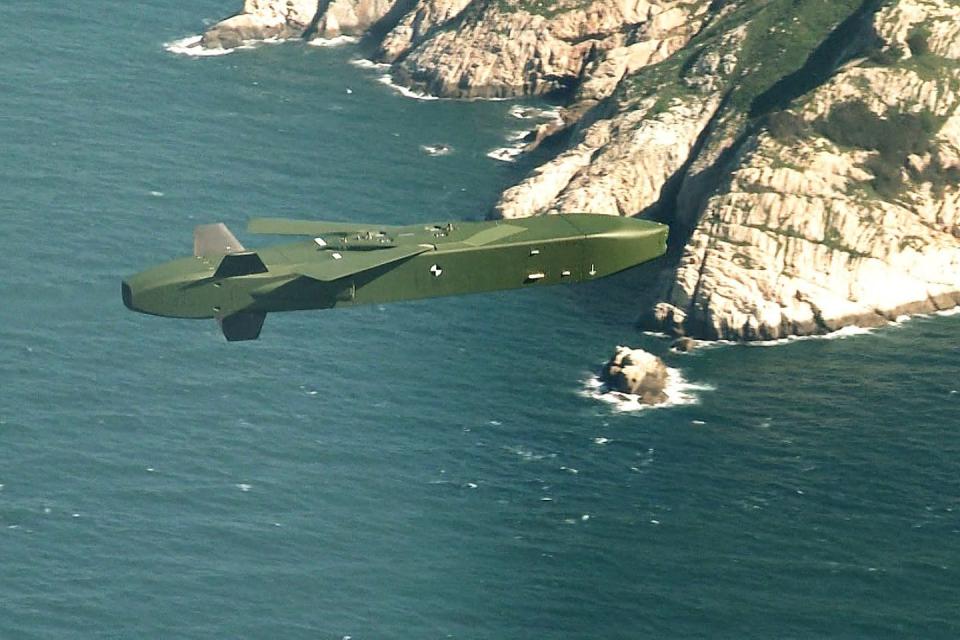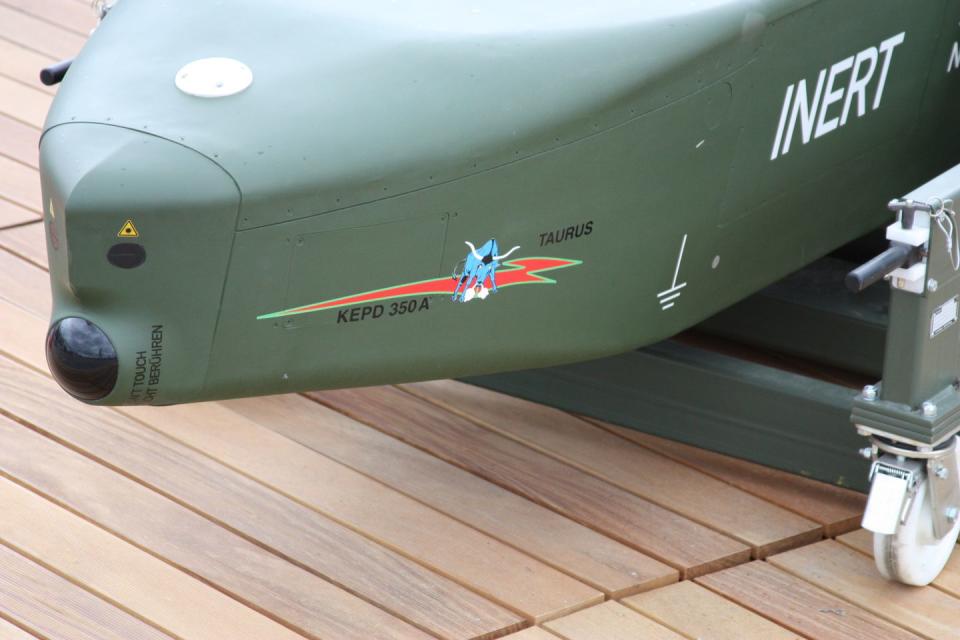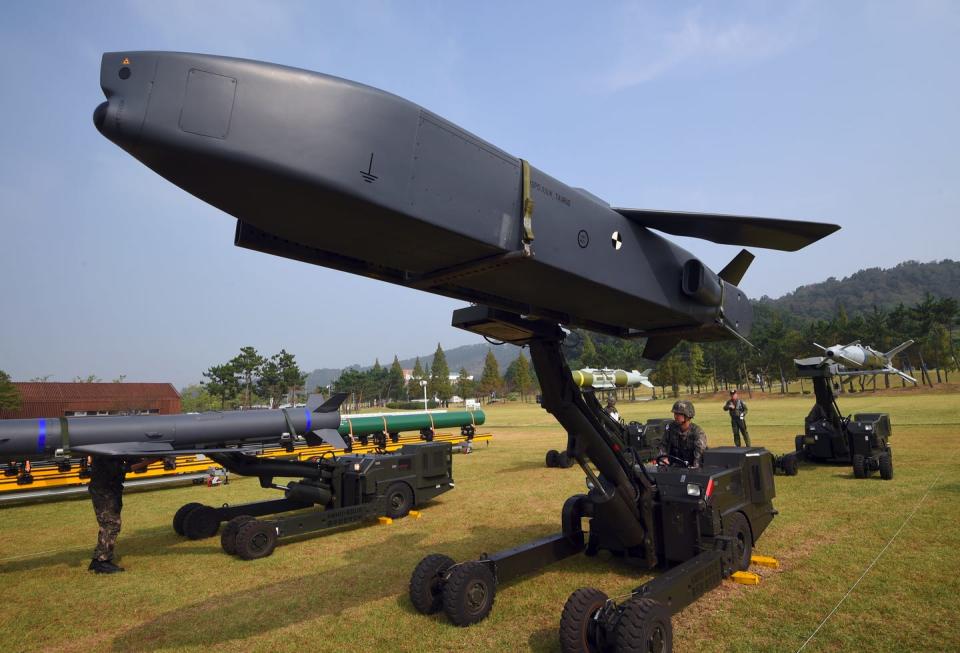Sure Sounds Like Germany Is Giving Ukraine the Mighty Taurus Cruise Missile

- Oops!Something went wrong.Please try again later.
On Monday, a Ukrainian diplomat suggested “key parliamentary factions”—including those in Scholz’s own SPD party—have reached a “consensus” in support of transferring some of Germany’s KEPD-350 Taurus stealth cruise missiles to Ukraine to aid in its struggle against invading Russian forces. Ukraine first formally requested the air-launched German-Swedish weapon in May.
Until now, the administration of Chancellor Olaf Scholz has opposed giving long-range strike weapons to Ukraine on the grounds they could be used to strike targets deep inside Russian territory, potentially leading to dangerous escalation.
One MP from the SPD, Andreas Schwarz, is public in his support for Taurus. And the MP speaking on behalf of the SPD’s foreign-policy group, Nils Schmid, said he wouldn’t “rule out the possibility” on condition such transfers were in concert with the United States.
But such a transfer would be Scholz’s decision to make with council from the Ministry of Defense—and he and defense minister Boris Pistorius have yet to indicate a change in their policy. Only last week, Pistorius stated that “the time for us to make a decision has not yet come,” and that these weapons were “not our top priority.”
Time will tell whether shifting political winds affect Scholz’s stance—and if they do, how soon that change occurs.
The KEPD-350 is broadly comparable to the Storm Shadow/SCALP-EG stealth cruise missile developed jointly by the UK and France, which began supplying Storm Shadows to Ukraine in spring and summer, breaking the taboo on long-range weapon transfers.
The first official view on the French SCALP EG missile on Ukrainian Su-24 pic.twitter.com/SXEBjNdFWi
— Special Kherson Cat 🐈🇺🇦 (@bayraktar_1love) August 6, 2023
Ukraine had given England assurances that it would not attack targets on Russian soil, which leaves eligible areas invaded and occupied by Russia back in 2014-2015 available— such as Crimea, and swathes of Donetsk and Luhansk oblasts. Germany would surely condition Taurus transfers on such an assurance, too.
Growing support in Berlin for transferring Taurus likely springs from the observation that Storm Shadow/SCALP proved effective for Ukraine, yet didn’t result in the dreaded escalation from Russia. Nor did Ukraine use the Western-supplied missiles in controversial ways. Effectively, the bluff was called on Russia’s deterrent threats.
A transfer to Ukraine would result in the first-ever combat use of Taurus, which is currently not in production. Germany claims that it only has 150 Taurus missiles operational out of the 600 received by the Luftwaffe from 2005 to 2010. However, manufacturer Taurus Systems (a two-thirds German, one-third Swedish joint venture) claims that the operational number is closer to 300. It’s unclear how many of the remainder could be refurbished back into service, and how quickly that could happen.
What Can the Taurus Do?
Each aluminum-skinned KEPD-350 Taurus measures 5.1 meters long and weighs just over 1.5 tons (3,100 lb.) Upon launch from an aircraft, fold-out wings, X-shaped maneuvering tail fins, and a powerful American Textron P8300-15 turbofan engine (AKA Williams F122) allow the boxy missile to cruise to target at 460 to 690 miles per hour, out to a range of 310 miles.

A laptop-based mission planning system programs a Taurus missile’s flight path and target reference images pre-mission, making it relatively easy to ‘bolt-on’ the large weapon to Soviet Su-24M bombers Ukraine has already adapted to deliver Storm Shadow missiles.
Upon being launched, a Taurus’s Tri-tech navigation system fuses multiple sensors and reference libraries to continually track its position and correct its course. Those include a ground-scanning infrared-imaging sensor, an on-board terrain map library for image-matching navigation, a laser-gyroscope built by Northrop-Grumman for inertial tracking, a radar altimeter for terrain-reference navigation, and a 12-channel jam-resistant GPS receiver. This allows Taurus to execute precision strikes even when GPS signals are being jammed, as Russia is doing with increasing frequency to reduce accuracy of GPS-guided rockets given to Ukraine.

A KEPD-350 can approach its target using one of five attack modes: low-altitude approach at 100 feet that pops up to high altitude, another pop-up mode at a shallower altitude, a dive attack from high altitude, an air-bursting surface-skimming overflight, or an even shallower trajectory approach for entering cavern-like structure or hangars built into mountains/cliff sides.
For the typical pop-up attack, a Taurus missile lunges upward on the final approach, giving the IR-imaging sensor in Taurus’s nose a better vantage to search below for a structure matching a 3D model of its pre-assigned target. Once identified, the missile dives at 90 degrees towards the target’s roof. If the missile can’t find its target, it’s programmed to crash somewhere it won’t cause collateral damage.
KEPD stands for ‘Kinetic Energy Penetrator and Destroyer’—hinting at its two-stage MEPHISTO warhead, which weighs 1,090 pounds and is equipped with two laser rangefinders.
Moments before impact, the missile releases a ‘precursor’ shaped charge weighing 220 pounds that blasts a hole in a hardened structure or underground bunker. That allows the larger 7.5-foot-long 880-pound penetrator to drop inside. Thanks to its PIMPF void-sensing smart fuse, the penetrator itself can be programmed to explode after having pierced through, say, a certain number of floors in an underground facility.
So, Taurus spells very bad news for personnel and weapons sensibly sheltered in underground bunkers to protect against such strikes.
It can also use a two-way datalink to allow for remote control by an operator while it transmits back video imagery. That could enable the missile’s use against moving targets, such as ships or ground vehicle columns, as well as a reconnaissance role for battle damage assessments before the weapon hits its target.
Taurus Versus Storm Shadow
Taurus and Storm Shadow share many similar capabilities, including a stealthy radar cross-section that greatly reduces the attrition caused by enemy air defenses.
The Taurus’s MEPHISTO warhead may be more effective at piercing and shattering bridge spans. Ukraine has frequently targeted bridges with its Storm Shadow missiles with mixed results.
I might be going against the grain with this one, but I am not yet convinced by Ukraine's approach to bridge-busting, which is an extremely challenging endeavor. This is because bridges are stury structures that can withstand multiple hits, even from 2,000 pound bombs. 1/ pic.twitter.com/iqbenGNcZL
— Fabian Hoffmann (@FRHoffmann1) August 6, 2023
But the biggest difference is range, thanks to Taurus’s more powerful and fuel-efficient turbofan engine. Storm Shadow officially has a range of 155 miles, though other sources hint that the actual figure may be more like 250 or 350 miles. While the range of Storm Shadows given to Ukraine remains unclear, export Storm Shadows typically are constrained to the lowest figure.
Meanwhile, Taurus has a range “in excess of” 310 miles—by some accounts, it may be as high as 430 miles. This would make it easy to comprehensively hit Russian bases across Crimea and eastern Ukraine, and allow Ukrainian Su-24s to launch further back in Ukrainian controlled airspace for their own safety.
Of course, that could enable strikes deeper into Russian territory including central Moscow. However, Ukraine has understandably held to promises not to use Western weapons for strikes on Russian soil, given its hopes to continue receiving such arms. Germany could also impose locks on missiles pre-delivery to block targeting beyond Ukraine’s border.
A Taurus-M model can also carry alternative payloads. It can dispense multiple 35-pound STABO rocket-propelled bombs designed to shatter concrete runways, or SMArt 155 parachute-deploying anti-tank bomblets which scan for armored vehicles below using an radar and infrared sensors. The latter are already deployed in combat by Ukrainian artillery.
Ok, I told you about the good news 🆕 an hour ago. Here is the confirmation video:
➖2 russian tanks were destroyed
☑️1 SMArt round
📍Coordinates 49.213183, 38.179750 - courtesy of @DefMon3
🌍https://t.co/Vgceht3AK9
🛡️26th Brigade🫡
📽️⬇️ pic.twitter.com/NmFp8b2IsC— ✙🍒 Constantine 🍒✙ (@Teoyaomiquu) April 13, 2023
Origins of the Taurus
Germany began developing Taurus in the mid-1990s after a failed attempted cooperation over France’s Apache anti-runway missile, which evolved into the French-British Storm Shadow. Taurus was intended for compatibility with the DWS-24 (renamed DWS-39) weapon dispenser that Germany developed with Swedish arms manufacturer Bofors for its Tornado IDS strike jets.
After a relatively rapid multinational testing process, Germany procured 600 Taurus missiles for €570 million (roughly $684 million USD in the exchange rates of the day), implying a rough unit cost of about $1.1 million apiece and including whatever extras were bundled in the deal. These were delivered between 2005 and 2010, and integrated both on Luftwaffe Tornados and newer 4.5-generation Eurofighter Typhoon jets.

Sweden also successfully integrated Taurus onto its JAS-39 Gripen jets, but didn’t order any. But Taurus did score a couple export clients.
Spain bought 43 Tauruses for its FA-18 Hornet jets for €57 million, while South Korea purchased 260 of a version called the KEPD-350K with a variant GPS receiver and anti-jamming system. Mounted on South Korea’s customized F-15K Slam Eagle fighter bombers, the Taurus actually plays a critical role in Seoul’s ‘kill chain’ defense strategy designed to destroy North Korean command-and-control of dug-in nuclear and conventional missile forces as rapidly as possible in the event of a war. South Korea and Germany are also working on a smaller-size KEPD-350K2 variant that could be carried on the former’s FA-50 Golden Eagle light fighter jets.
Taurus Systems has proposed a few variant Taurus missiles, including models designed to launch from the open rear ramp of cargo aircraft (Taurus T), or surface-launched from containers that could be plonked onto trucks or ships (Taurus CL). A mysterious Modular Payload model was possibly intended for electronic warfare or microwave-weapon payloads (Taurus MP or HPM). There’s also a reduced-mass variant (KEPD-150 Taurus-L) with smaller fuel supply and warhead, and a proposed anti-ship model.
Taurus's Potential Impact on Russia's War in Ukraine
Should Scholz supply Taurus missiles to Ukraine, the most important impact would simply be expanding Ukraine’s long-range cruise missile stockpile, which it must use very selectively given limited quantities built. According to Fabian Hoffman—an expert on missile technology at the University of Oslo—Ukraine’s Storm Shadow/SCALP inventory will likely peter out between October of 2023 and January of 2024, depending on how many France and England donated.
Depending on how many Storm Shadow/SCALP-EG ALCMs 🇺🇦 has received, and assuming Ukraine maintains its current rate of consumption of about 75 missiles per month, it will run out of long-range strike capabilities somewhere between October 2023 and January 2024. 1/ pic.twitter.com/BoZxt9eHwO
— Fabian Hoffmann (@FRHoffmann1) August 7, 2023
Thus, donating Taurus would result in a greater ability for Ukraine to sustain or even intensify deep strikes to degrade Russian logistics, command, and control in support of Ukraine’s slow-moving counter offensive.
That said, Taurus’s expanded range also would improve Ukraine’s strike options across Crimea, Donetsk, and Luhansk, making it impossible for Russia to keep depots and command posts out of range while on occupied soil. It could facilitate attacks on Russian ships deeper into the Black Sea, and enable hard-working Su-24M bombers of Ukraine’s 7th Tactical Aviation Brigade to stage from bases and launch their weapons further back from Russian fighter patrols and ground-based missiles. Russia has repeatedly tried and failed to destroy those Su-24s on the ground.
Meanwhile, Germany may consider refurbishing its hundreds of non-operational Taurus missiles, and restarting production to replenish and enlarge its inventory as well as sustain any it may give to Ukraine. Hoffman notes that the idea of a second Taurus order has been raised, but that restarting production would take one or two years. “That’s why the best time to start preparations for renewed production was yesterday and the second-best time is today.”
You Might Also Like

